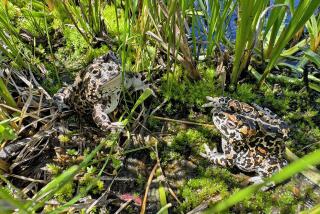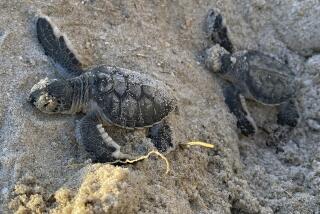Sea Turtle Gets Into Hot Water--and Out
- Share via
A rare and endangered sea turtle whose ancestors go back to prehistoric times found itself trapped early Thursday in one of man’s most modern contraptions, a huge intake pipe of the San Onofre Nuclear Generating Station near San Clemente.
The 40-pound green sea turtle, with a two-foot-long shell, was rescued from the pipe by plant workers and turned over to the Friends of the Sea Lions Marine Mammal Center in Laguna Canyon.
“It seems to be in good shape,” Karin Wyman, curator at the center, said of the young turtle thought to have migrated 3,000 miles from the Galapagos Islands off the coast of Ecuador. “It had some small abrasions on its head and on one front flipper, but we think it’s ready to go back in the ocean.”
Bill Ford, director of the center, said, “We’re used to handling sea lions and seals and elephant seals, but this is the first sea turtle we’ve ever had.”
Green sea turtles are considered tropical animals, but they sometimes swim as far north as San Diego and Orange counties during the summer when the water is warm, said Mike Shaw, curator of fishes at San Diego’s Sea World.
Shaw said the turtles are native to the Galapagos Islands and parts of Central America, and are on the federal endangered species list.
Judging from the size of the one caught Thursday, Shaw said, he believes that it was a juvenile about 8 to 10 years old. A normal adult weighs up to 200 pounds and can live up to 100 years.
“Once they get up here,” he said, “they are attracted to such places as the San Onofre plant where sea water is used as a coolant. During the process, the water itself is heated up before being returned to the ocean, and this appeals to such creatures as the turtles and other tropical species. And they are inclined to hang around.”
Dave Barron, spokesman for Southern California Edison Co., one of the nuclear plant operators, said the turtle was drawn into an 18-foot-diameter intake pipe serving the plant’s No. 3 unit.
“The pipe runs offshore more than half a mile,” Barron said, “and it is equipped with baffles that shunt fish and other sea animals into a pool before they get into the cooling system. We’ve often caught seals and sea lions like this, and we always try to get them to the Friends of the Sea Lions for care.”
Wyman said the turtle was released to the ocean late Thursday “on a quiet beach after most people had gone home.”
Shaw said it was his bet the turtle would, by instinct, start swimming south, “and probably end up in the warm water put out by the nuclear plant and probably just try to stay there.”
More to Read
Sign up for Essential California
The most important California stories and recommendations in your inbox every morning.
You may occasionally receive promotional content from the Los Angeles Times.













